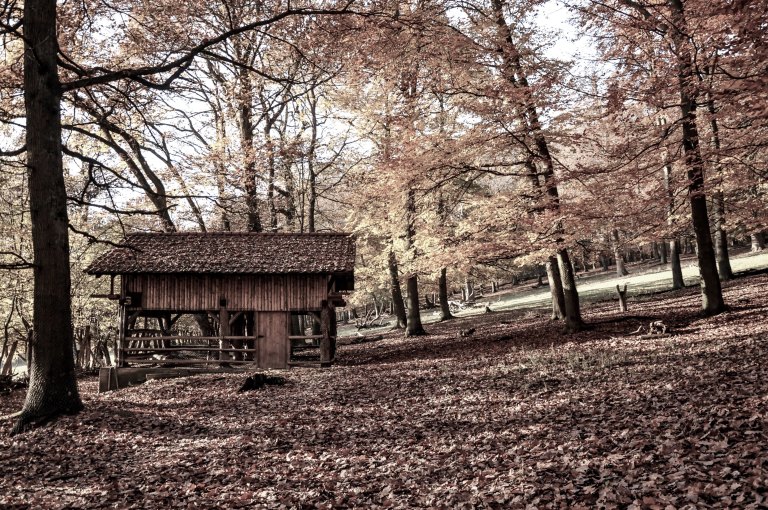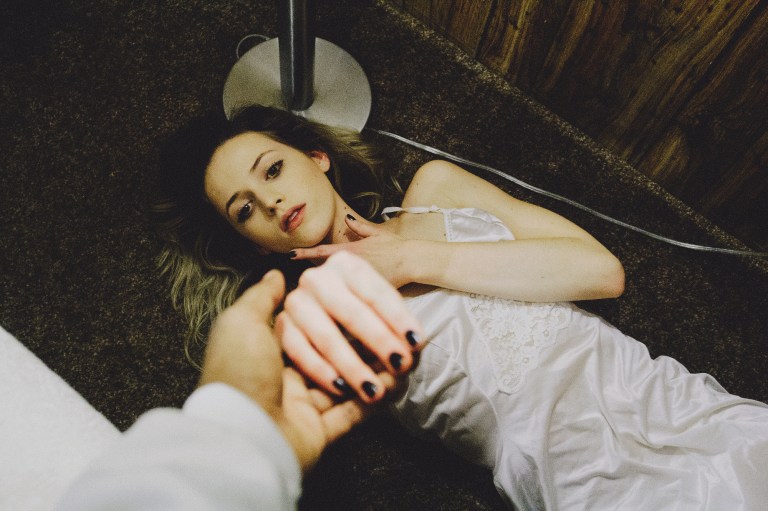Castle Of The Living Dead: Time, Embalmed
What makes seemingly throwaway images get stuck in the hippocampus and stay there, for a lifetime?
By Mark Dery



Castle of the Living Dead (1964) is, by universal consensus, not high art. An especially forgettable example of the spaghetti-gothic thrillers turned out by Italian moviemakers in the ’60s, it’s a low-budget affair, badly dubbed, creaky with clichés, marred by hammy performances. Yet, for all its staginess, the film settled to the bottom of my unconscious the day I saw it, at the age of eight or nine, and has lain there ever since, submerged but still visible, like the drowned death car in Night of the Hunter.

Maybe it made an indelible impression simply by virtue of being an early, uncommonly weird contribution to the fund of cinematic images swelling my visual memory, an account whose deposits had consisted, until then, of G-rated fare like Oliver, Doctor Doolittle, and Camelot. My mom, a vocal foe of the plug-in drug, had declared our house a TV-free zone, so it was in the next-door neighbors’ living room, where the set was tuned to San Diego’s own Science Fiction Theater, that I first encountered Castle of the Living Dead.
It was a drowsy December afternoon sometime in the late ‘60s, radioactively sunny if memory serves, and the neighbor lady (whose husband, Angel, was Mexican—a startling oddity itself, in our Wonder Bread suburb) had made tamales de dulce. Gift-wrapped in neatly tied cornhusks, the little bundles of creamy, savory-sweet masa, flecked with cinnamon and studded with raisins, were my first encounter with echt Mexican food, a world away from Taco Bell. (We don’t need Proust to remind us that sense memory plays a profound role in writing our personal histories, forging unbreakable links between embodied experience and emotional valence.)

Munching my tamale contentedly as the show’s Elvira-esque host, Moona Lisa, camped her way through a pun-ridden introduction, I was utterly unprepared for the movie’s sick-funny grotesquerie. The title sequence, shot in the 16th-century Park of the Monsters in Bomarzo, Italy, foreshadows that theme, bringing us face to face with the grotto of the Orcus, a mammoth stone ogre’s head whose gaping maw represents the entrance to Hell. The film abounds in grotesque moments: an itinerant troupe of commedia dell’arte players, making its way through rural Italy in the early 19th century, just after the Napoleonic Wars, performs a ghoulish act in which Harlequin tricks his executioner into hanging himself—to the guffaws and leers of a crowd of rubes who wouldn’t be out of place in a Diane Arbus photo. Summoned to perform their act for the usual degenerate aristocrat (the sepulchral, sunken-eyed Count Drago, played by Christopher Lee) at the usual gothic pile in the remote countryside, the troupe encounters more than the usual grotesqueries. One by one, the players are picked off by the usual leering henchman—in one instance, by means of an arrow in the eye, shot, bizarrely, from a miniature crossbow. (“Sandro has an affinity for the bizarre forms of death,” the count deadpans).
Creepiest of all, the count lives alone (but for his depraved retainer, Sandro) in a cabinet of taxidermic curiosities. Every room in the castle is crammed with mounted specimens frozen in lifelike attitudes; the irresolvable tension between tableau vivant and nature morte makes them textbook examples of the Freudian Uncanny. “They’re all so perfectly done—as if they were going to fly or jump from their perches,” a member of the troupe marvels. The count is philosophical: “They enjoy something that few of us ever attain: the illusion of eternal life. In death, they exist like this forever.”
Of course, Drago’s displays aren’t any more unsettling, really, than the habitat dioramas in any natural-history museum, especially the older, untended ones, their glass-eyed inhabitants mangy with age, more undead than lifelike. Isn’t every natural-history museum an embalmed Eden, bestowing the “illusion of eternal life” on endangered species and threatened habitats?
Then again, aren’t museum scenes in vitrines metaphors for our desire—indistinguishable, come to think of it, from Drago’s obsession—to preserve significant moments of our lives just as they are, with the fixative of memory, so we can revisit them whenever we want to? Think of Holden Caulfield’s poetic reverie, in Catcher in the Rye, about the American Museum of Natural History, the site of grade-school pilgrimages when he was a kid:
The best thing, though, in that museum was that everything always stayed right where it was. Nobody’d move. You could go there a hundred thousand times, and that Eskimo would still be just finished catching those two fish, the birds would still be on their way south, the deers would still be drinking out of that water hole, with their pretty antlers and their pretty, skinny legs, and that squaw with the naked bosom would still be weaving that same blanket. Nobody’d be different. The only thing that would be different would be you. … Certain things they should stay the way they are. You ought to be able to stick them in one of those big glass cases and just leave them alone. I know that’s impossible, but it’s too bad anyway.
Isn’t that Drago’s dream?
After Psycho, it’s impossible to see taxidermy as anything other than symbolic shorthand for arrested development at its creepiest; nerdiness taken to pathological extremes. It’s the hobby of choice for weirdoes whose fondness for playing with dead things hints, none too subtly, at sublimated necrophilia. (Certainly, the air of unwholesomeness hanging over Count Drago suggests some sort of perversion; his raccoon-ring eyes and sickly pallor remind us of Victorian warnings about the evil effects of self-abuse.)

In Castle of the Living Dead, however, taxidermy—or, more properly, the “aqueous secretion of a tropical plant,” which kills instantly but preserves forever—is a technology for stopping time. Sounding a note of postmodern melancholy, the count laments that, despite his perfection of the “techniques for the skinning, curing, and mounting of specimens,” the results of his morbid artistry were, inescapably, simulacra—“painstaking recreations” merely, “never an original.” He dreams of an impossibility, not exactly Baudrillard’s hyperreality of representations without originals, but rather the thing transformed into a counterfeit of itself: “an instant suspension of life that would endure forever.” And there’s the rub: to the victim, the count’s miraculous poison means instant death; to the count, a corpse so lifelike it’s unmistakable from a living thing is immortal, even if, paradoxically, it’s dead.
In that sense, Count Drago’s uncanny simulacra remind us of the kinship between taxidermy and photography, which arrests the flight of time, fixing the moment forever. The movie’s bargain-basement special effects literalize this metaphoric connection: when a cat laps up some brandy spiked with the count’s elixir of death, it freeze-frames blurrily, a time fossil trapped in the amber of a filmed instant. Oliver Wendell Holmes took note of this connection in the art’s infancy: in his 1859 essay, “The Stereoscope and the Stereograph,” Holmes announces the coming of the Matrix reality we now inhabit, where reproductions and originals are increasingly indistinguishable.
Form is henceforth divorced from matter. In fact, matter as a visible object is of no great use any longer, except as the mold on which form is shaped. Give us a few negatives of a thing worth seeing, taken from different points of view, and that is all we want of it. … Matter in large masses must always be fixed and dear; form is cheap and transportable. We have got the fruit of creation now, and need not trouble ourselves with the core. … Men will hunt all curious, beautiful, grand objects, as they hunt the cattle in South America, for their skins, and leave the carcasses as of little worth.
The count’s problem is that it’s sometime around 1815, photography hasn’t been invented yet, and he’s trying to create the “instant suspension of life” that photography will soon make possible—taxidermy with the snap of a shutter, skinning the image to preserve it for eternity. In his graveside eulogy for one of the hapless troupers dispatched with his potion, Drago intones 1 Corinthians 15:51-52, “Behold, I show you a mystery; we shall not all sleep, but we shall all be changed, in a moment, in the twinkling of an eye…” Paul is talking about the Rapture, when dead believers will rise at the sound of the last trumpet, reborn in incorruptible bodies. But he could just as easily be talking about photography’s ability to embalm time. Or, for that matter, memory’s.
There’s something about Castle of the Living Dead, a low-lying fog of uncanniness that first runs a cold finger down your spine when the players, passing through an eerily silent wood, happen on what appears to be a stuffed raven perched on the limb of a tree. A member of the troupe observes that the bird looks as if it has glass eyes—an image straight out of Freud’s essay on the uncanny, and one that reverberated in my mind as a grade-schooler. The petrified forest, I thought, a phrase that for me has always had an incantatory power, evoking not the Late Triassic trees fossilized in the Arizona desert but a world in which the second hand on every watch has frozen in mid-tick and the droplets of hissing sprinklers hang suspended, bejeweling the air. Looking back, it occurs to me that memory (indistinguishable, in our time, from the visual tropes of photography and cinema) is Count Drago’s time-stopping concoction, suspending life instantly so that it endures forever.
Angel is gone to dust, I suspect.
My mom is a glassy eyed likeness of her former self, her mind erased by Alzheimer’s, wordlessly keening at the oncoming shadows as the sun sets on her assisted-living facility. Sundowning, they call it: the confusion and anxiety brought on, in some Alzheimer’s sufferers, by the waning of daylight. Researchers believe it’s caused by the damage the disease inflicts on that part of the brain that maintains our circadian rhythms.. The last time I visited my mom, the TV was on and they’d pointed her toward it, but whether the constantly shifting patches of light and dark on the screen meant anything to her is anyone’s guess.
The house I grew up in, the standard-issue stucco-clad ‘50s tract home, has seen several owners since my family sold it, the last of whom saw fit to buzzsaw the few remaining trees on the plot.

I can still remember wandering the yard the morning after we moved in, amazed at the exotic flora—a developer’s nod to mythic visions of sunny California as a cornucopia, so impossibly fertile that things grew with astonishing speed, and to prodigious size: melons grew with such rapidity, tall tales had it, that they were bruised as they bumped across the ground, yanked along by the runaway growth of their vines; pumpkins as big as houses were commonplace. (The California historian Carey McWilliams, who recounts these yarns in Southern California: An Island on the Land, traces this promotional folklore to the 1870’s, when a rising middle class yearned for “an Italy nearer home,” a Mediterranean idyll on the Pacific where they could “live out their days in the sun.”)
In our back yard stood a banana tree, of all preposterous things, and peach and plum and nectarine trees, too, and a crabapple tree and a pomegranate bush, and a pine tree twice as high as the house, if not higher. Later, I would climb it whenever I wanted to escape the claustrophobic airlock of family life. Straddling a bough several stories up, my face tickled by the whiskbrooms of pine needles, I would survey our little corner of San Diego sprawl like a lookout in a crow’s nest, swaying gently as the tree tossed its head in the breeze. There was a natal plum bush, its forked thorns vicious as medieval weaponry, and a candelabra aloe, a sprawling succulent whose writhing, barbed tentacles made it look as if it had just crawled out of one of the Martian tripods in H.G. Wells’s War of the Worlds.
As a kid, I spent dreamlike summers loafing contentedly in the shade of the nectarine tree, reading library books and drinking my body weight in Kool-Aid. Around the side of the house, a fig tree toed the property line between our lot and Angel’s, its wrinkly gray trunk reminiscent of elephant hide. My stepdad caught me and my girlfriend there, she 13, I 14, perilously close to third base. Beside it was an apricot tree, whose fruits concealed in their pits little nuts like wizened almonds, rich in cyanide or something like it, close enough to kill you if you gorged yourself on the things. I ate them unconcernedly, prying the pits open with my jackknife, like oysters.
The trees are gone, every one of them, and the aloe bush, and the hedges that stood guard between our back yard and Angel’s, unmourned victims of the suburban mania for the manicured lawn, our horror of unruly nature outside a vitrine, or a SeaWorld aquarium, or a Disney robot ride. The house is square. The yards, front and back, are square. The blank patch of concrete patio that dominates the denuded backyard is square, square as a headstone. The streets are wide, vast gulfs of blacktop separating houses whose blinds are always drawn, whether against the pitiless sun or any threat of neighborliness, who knows? The desert sun irradiates the sidewalks, burns the scruffy patches of grass brown, bleaches the life out of everything, a glare so bright it makes your mind squint. Nothing human moves on these empty, always empty, streets.
The past is a petrified forest. ![]()




